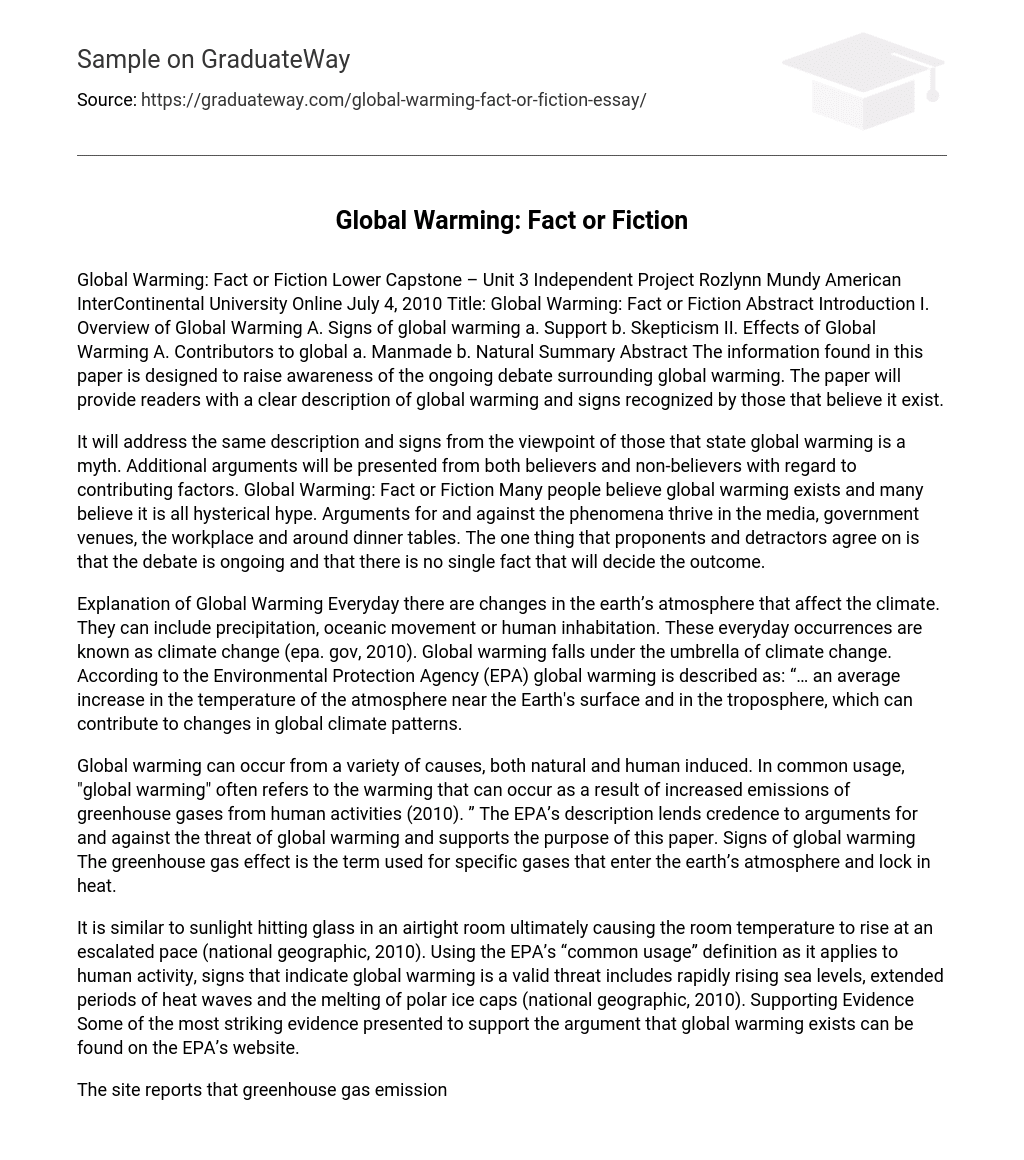This paper aims to increase awareness about the ongoing discussion surrounding global warming. It will provide a concise explanation of global warming and its recognized indicators according to believers, as well as delve into the perspective of skeptics who view it as a fabrication. Additionally, it will present arguments from both supporters and opponents regarding the contributing factors of global warming.
There are varying opinions on global warming, with some considering it a reality and others seeing it as exaggerated hype. This debate is happening in different arenas like media, government settings, workplaces, and dinner conversations. Regardless of their position, both supporters and critics acknowledge that there is no conclusive fact to settle the issue.
According to the Environmental Protection Agency (EPA) (source: epa.gov, 2010), global warming refers to an increase in temperature near the Earth’s surface and troposphere, which can cause changes in global climate patterns. Conversely, climate change encompasses everyday variations in atmospheric conditions such as precipitation, oceanic currents, and human habitation.
Global warming can result from various causes, whether natural or human-induced. In everyday language, the term “global warming” often signifies the heating that may arise due to elevated emissions of greenhouse gases caused by human activities (2010). The EPA’s explanation supports both sides of the global warming debate and is consistent with the objective of this paper. Indications of global warming are evident through the greenhouse gas effect, wherein certain gases enter Earth’s atmosphere and retain heat.
According to a National Geographic article from 2010, global warming has a similar effect as sunlight hitting glass in a confined space, causing the temperature of the room to rise quickly. The Environmental Protection Agency (EPA) identifies rising sea levels, prolonged heat waves, and melting polar ice caps as valid concerns for global warming based on their “common usage” definition (National Geographic, 2010). On their website, the EPA provides various convincing evidence to support the existence of global warming.
According to the website, greenhouse gas emissions in the U.S. have increased by 14% from 1990 to 2008 and globally by 26% from 1990 to 2005. Additionally, the website notes that acidity levels in our oceans, which affect certain marine life, have risen over the past two decades (2010). The EPA’s report further provides statistical evidence of global warming through the reduction of polar ice caps in Arctic regions and the warming of our ecosystem (2010).
Both proponents and skeptics of global warming can present evidence to support their perspectives. Al Gore, the former Vice President, has provided arguments in favor of acknowledging global warming as a reality. However, Senator James Inhofe has presented counterarguments. In 2006, Sen. Inhofe referenced two Canadian researchers who raised doubts about the credibility of scientist Michael Mann’s hockey stick graph, which illustrated a substantial increase in global warming. It is worth noting that the National Academy of Science also dismissed the hockey stick graph in that same year (epwsenate.gov, 2009).
Effects of global warming, also known as “fingerprints” by scientists, are described as harbingers that give warnings about future events and indicate the impact on the Earth and humanity (National Geographic, 2010). These harbingers include increased disease rates, altered migration patterns and habitats of animals, more frequent and stronger storm activities, and heightened wild fires due to reduced precipitation (2010).
The earth’s temperature and greenhouse gases have historically gone through regular fluctuations, but there has been a significant deviation from the normal pattern in recent times. It is widely accepted that human activities during the industrial age have affected the greenhouse effect and caused this change in global warming. This belief is supported by evidence indicating that elements such as air pollution and industrial waste are adding to the increase in temperatures (National Geographic, 2010).
Human activities, which involve the utilization of fossil fuels like coal, oil, gas, and other organic compounds for energy production, are responsible for pollution in both air and ecosystems. The combustion of these resources not only increases the earth’s atmospheric temperature but also plays a crucial role in inducing global warming (source: national geographic, 2010).
There are people who dispute the notion that global warming is a confirmed reality, arguing instead that it is a natural phenomenon. They support their viewpoint by referring to historical data collected by scientists, which highlights natural occurrences that contribute to the Earth’s rising temperature. Examples of these occurrences include sun spots, major volcanic eruptions, meteor impacts, and fluctuations in the Earth’s rotation (Peer Curriculum, 2003).
When considering both sides of the global warming debate and taking into account all perspectives, valid arguments can be found from supporters and skeptics who provide scientific evidence to support their claims and provoke opposition. The research aims to highlight the current state of the global warming issue, leading to the conclusion that this ongoing debate is significant and will continue in the foreseeable future.
References
- epa. gov ( 2010) Climate Change. Retrieved July 1, 2010 from http://www. epa. gov/climatechange/ epwsenate. gov
- (2009) U. S. Senate Minority Report: More Than 700 International Scientists Dissent Over Man-Made Global Warming Claims Scientists Continue to Debunk “Consensus” in 2008 & 2009. Retrieved July 2, 2009 from http://epw. senate. gov/public/index. cfm? FuseAction=Files. View=83947f5d-d84a-4a84-ad5d-6e2d71db52d9
- National Geographic (2010) What is Global Warming. Retrieved July 2, 2010 from http://environment. nationalgeographic. com/environment/global-warming/gw-overview. html





